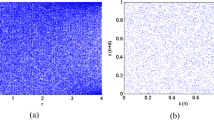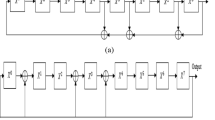Abstract
An encryption algorithm based on sparse coding and compressive sensing is proposed. Sparse coding is used to find the sparse representation of images as a linear combination of atoms from an overcomplete learned dictionary. The overcomplete dictionary is learned using K-SVD, utilizing non-overlapping patches obtained from a set of images. Compressed sensing is used to sample data at a rate below the Nyquist rate. A Gaussian measurement matrix compressively samples the plain image. As these measurements are linear, chaos based permutation and substitution operations are performed to obtain the cipher image. Bit-level scrambling and block substitution is done to confuse and diffuse the measurements. Simulation results verify the performance of the proposed technique against various statistical attacks.




Similar content being viewed by others
References
Aharon, M., Elad, M., & Bruckstein, A. (2006). K-SVD: An algorithm for designing overcomplete dictionaries for sparse representation. IEEE Transactions on Signal Processing, 54(11), 4311–4322.
Ashwini, K., & Amutha, R. (2018). Compressive sensing based simultaneous fusion and compression of multi-focus images using learned dictionary. Multimedia Tools and Applications, 77(19), 25889–25904.
Baraniuk, R. (2007). Compressive sensing [Lecture Notes]. IEEE Signal Processing Magazine, 24, 118–121.
Cambareri, V., Mangia, M., Pareschi, F., Rovatti, R., & Setti, G. (2015). On known-plaintext attacks to a compressed sensing-based encryption: A quantitative analysis. IEEE Transactions on Information Forensics and Security, 10(10), 2182–2195.
Candes, E., & Wakin, M. (2008). An introduction to compressive sampling. IEEE Signal Processing Magazine, 25(2), 21–30.
Candes, E. J. (2008). The restricted isometry property and its implications for compressed sensing. Comptes Rendus Mathematique, 346(9–10), 589–592.
Chen, T., Zhang, M., Wu, J., Yuen, C., & Tong, Y. (2016). Image encryption and compression based on kronecker compressed sensing and elementary cellular automata scrambling. Optics & Laser Technology, 84, 118–133.
Donoho, D. L. (2006). Compressed sensing. IEEE Transactions on Information Theory, 52(4), 1289–1306.
Engan, K., Skretting, K., & Husøy, J. H. (2007). Family of iterative LS-based dictionary learning algorithms, ILS-DLA, for sparse signal representation. Digital Signal Processing, 17(1), 32–49.
Hanis, S., & Amutha, R. (2019). A fast double-keyed authenticated image encryption scheme using an improved chaotic map and a butterfly-like structure. Nonlinear Dynamics, 95(1), 421–432.
Hu, G., Xiao, D., Wang, Y., & Xiang, T. (2017). An image coding scheme using parallel compressive sensing for simultaneous compression-encryption applications. Journal of Visual Communication and Image Representation, 44, 116–127.
Huang, R., Rhee, K. H., & Uchida, S. (2014). A parallel image encryption method based on compressive sensing. Multimedia Tools and Applications, 72(1), 71–93.
Huang, R., & Sakurai, K. (2011). A robust and compression-combined digital image encryption method based on compressive sensing. In Proceedings: 7th International Conference on Intelligent Information Hiding and Multimedia Signal Processing, IIHMSP 2011, pp. 105–108.
Huang, W., & Jing, Z. (2007). Evaluation of focus measures in multi-focus image fusion. Pattern Recognition Letters, 28(4), 493–500.
Olshausen, B. A., & Field, D. J. (1997). Sparse coding with an overcomplete basis set: A strategy employed by V1? Vision Research, 37(23), 3311–3325.
Orsdemir, A., Altun, H. O., Sharma, G., & Bocko, M. F. (2008). On the security and robustness of encryption via compressed sensing. In Proceedings: IEEE Military Communications Conference MILCOM.
Ponuma, R., & Amutha, R. (2018). Compressive sensing and chaos-based image compression encryption. In Advances in Soft Computing and Machine Learning in Image Processing, pp. 373–392. Springer.
Ponuma, R., & Amutha, R. (2018b). Compressive sensing based image compression-encryption using novel 1d-chaotic map. Multimedia Tools and Applications, 77(15), 19209–19234.
Ponuma, R., & Amutha, R. (2018). Encryption of image data using compressive sensing and chaotic system. Multimedia Tools and Applications. https://doi.org/10.1007/s11042-018-6745-3.
Skretting, K., & Engan, K. (2010). Recursive least squares dictionary learning algorithm. IEEE Transactions on Signal Processing, 58(4), 2121–2130.
Tropp, J. A., & Gilbert, A. C. (2007). Signal recovery from random measurements via orthogonal Matching Pursuit - Semantic Scholar. IEEE Transactions on Information Theory, 53(12), 4655–4666.
Xu, L., Li, Z., Li, J., & Hua, W. (2016). A novel bit-level image encryption algorithm based on chaotic maps. Optics and Lasers in Engineering, 78, 17–25.
Zahmoul, R., Ejbali, R., & Zaied, M. (2017). Image encryption based on new Beta chaotic maps. Optics and Lasers in Engineering, 96, 39–49.
Zhang, Y., Zhou, J., Chen, F., Zhang, L. Y., Wong, K.-W., He, X., et al. (2016). Embedding cryptographic features in compressive sensing. Neurocomputing, 205, 472–480.
Zhou, N., Pan, S., Cheng, S., & Zhou, Z. (2016). Image compression-encryption scheme based on hyper-chaotic system and 2D compressive sensing. Optics & Laser Technology, 82, 121–133.
Zhou, N., Zhang, A., Wu, J., Pei, D., & Yang, Y. (2014a). Novel hybrid image compression-encryption algorithm based on compressive sensing. Optik, 125(18), 5075–5080.
Zhou, N., Zhang, A., Zheng, F., & Gong, L. (2014b). Novel image compression-encryption hybrid algorithm based on key-controlled measurement matrix in compressive sensing. Optics & Laser Technology, 62, 152–160.
Author information
Authors and Affiliations
Corresponding author
Ethics declarations
Conflict of interest
The authors declare that they have no conflict of interest.
Additional information
Publisher's Note
Springer Nature remains neutral with regard to jurisdictional claims in published maps and institutional affiliations.
Rights and permissions
About this article
Cite this article
Ponuma, R., Amutha, R. Image encryption using sparse coding and compressive sensing. Multidim Syst Sign Process 30, 1895–1909 (2019). https://doi.org/10.1007/s11045-019-00634-x
Received:
Revised:
Accepted:
Published:
Issue Date:
DOI: https://doi.org/10.1007/s11045-019-00634-x




